Written by: James Hart
In a world like ours, businesses can’t afford to take workplace safety for granted. There’s a long list of reasons why preparedness and planning must be a priority for companies of all sizes.
“It should go without saying that just caring for your people — the human element — should be at the top of the list,” said Archie Dinwiddie, vice president of risk management, training and compliance at Chesley Brown, the security management and consulting firm.
“But if we talk about it from a business standpoint, risk exposure is also a big part of it.”
A company with a poor safety record can face OSHA investigations and fines, lawsuits, a loss of certifications and licenses, higher insurance rates and negative PR.
“It can impact employee retention, too,” Dinwiddie said. “Because there comes a point where you might have a hard time finding employees or retaining them if they feel like people aren’t safe.”
Fortunately, there are several steps that organizations can take to prevent workplace injuries and deaths. In this post, you’ll learn more about the most common safety threats and the best strategies for addressing each one.
Crime prevention and violent attacks
Unfortunately, the workplace has become an increasingly common target for violent crime. In 2022, workplace homicides claimed the lives of 524 people, according to the US Bureau of Labor Statistics. While some industries have higher rates of death, violence can strike anyone in any field.
Your security program should include surveillance cameras, access controls, alarm systems and other devices that make it harder for bad actors to physically enter the property.
But one of the most important investments you can make is in training. Employees should be taught to recognize and report suspicious activity, whether that’s among customers or fellow workers. An early heads-up could make all the difference in preventing a tragedy.
“So often there are warning signs beforehand that people either ignore or don’t necessarily notice,” Dinwiddie said. “That’s part of what we try to incorporate into the training. Be on the lookout for some of those behaviors, in case it’s possible to intervene at that stage.”
And if the worst does happen, your team should know what to do, though that will depend on the nature of your workplace. Chesley Brown can help devise protocols for preparing for and responding to these kinds of threats, including leading active shooter drills.
Because different clients have different needs, the firm will tailor its programs according to the type of property, whether it’s a retail location, a corporate or academic campus, manufacturing facilities or high-rises and other types of office space.
Natural disasters
Almost every business will eventually find itself affected by a disaster, whether it comes in the form of a deadly heatwave, an outbreak of life-threatening storms or a record-breaking earthquake. And the costs could be massive.
Last year, the US recorded 28 disasters that caused more than $1 billion in damage, setting a new record, up from 22 such incidents in 2020. The total cost was at least $92.9 billion, the National Oceanic and Atmospheric Administration said.
Forward-looking organizations should make sure they have comprehensive plans for the disasters most likely to strike their area. So if a hurricane, fire or flood happens, team members don’t have to think about what to do. They just need to go to the plan and execute it.
Each type of disaster will require different types of responses, but most preparedness plans should include:
- Evacuation routes that clearly show employees, customers and visitors how to safely leave the building. Or they may show places where people can take shelter.
- Communication plans for reaching employees, both before disaster strikes and after, especially if phone and internet service are lost. The plan should also consider how to communicate to customers, business partners and the general public if the disaster forces the business to close for some time.
- Emergency supplies, such as first-aid gear, battery-powered radios, food and water, and other necessities. If a disaster is serious enough, it could take hours for first responders to deliver help. To the best of its ability, your team needs to be able to function on its own in an emergency.
- Business continuity resources, which could include a backup location, alternate vendors and service providers, specialty insurance and other tools to help the organization get up and running again as quickly as possible.
- A strategy for preserving and restoring essential data. Cloud-based apps and storage make this easier, but depending on the nature of their business, some organizations may need to back up their essential data to off-site servers, or even have physical copies.
These plans should be updated at least once a year, or whenever new information is available. (For example, maybe an evacuation route is now blocked by a construction project.) In the aftermath of any disaster, the employee or team overseeing disaster prep should debrief to review how the response worked and what could be improved.
And that information should be communicated to the larger organization. Employees should be trained and drilled on disaster response, though how often will depend on the nature of the threat. A business along the coast might be fine with a drill before hurricane season starts and periodic reminders about what to do in the event of an emergency.
Learn more about disaster preparedness and business continuity in this post.
Workplace accidents
One of the most persistent threats to employees is workplace accidents. Almost 5,500 US workers were killed in on-the-job incidents in 2022. It’s the equivalent of a worker dying every 96 minutes.
And that’s not counting the 2.8 million people who suffered a nonfatal workplace injury or illness.
Fortunately, there are several steps that companies can take to protect their teams, including:
- Conducting regular risk assessments for potential hazards, and taking action to address them. It can pay to have an outside expert conduct these assessments. Not only do they bring a wider array of expertise, it can be easy for internal teams to overlook issues in places they see every day.
- Providing necessary safety equipment to employees and training them to use it. There should also be systems to check and replace gear when necessary.
- Conducting regular inspections and maintenance of machinery and equipment, reducing the risk of accidents.
- Educating the workforce about ways to prevent repetitive stress and ergonomic injuries.
Safety culture
Even the most dedicated organizations will struggle to prepare for every single threat. But you can increase your team’s ability to respond to any potential danger by creating a safety culture — a workplace where everyone values and takes responsibility for promoting safety.
Though it isn’t possible to simply “declare” a safety culture, leaders play an important role in building one by prioritizing safety in operations and making investments in resources that further that goal. Those investments could include better lighting in the employee parking lot, an effective closed-circuit TV system or automated external defibrillators (AEDs) in case an employee suffers a heart attack.
“When it comes to safety and security in the workplace,” Dinwiddie said, “you’ve got to make a real investment, whether that means hiring uniformed security officers or spending the time to put good procedures in place and practice them.”
For example, open communication is an essential part of safety culture. Employees must feel empowered to raise concerns about safety without getting in trouble with management. Leadership can play a big part in encouraging that spirit.
“Somebody at the top does have to genuinely care about workplace safety and see the value in it,” Dinwiddie said.
A focus on continuous improvement is another key to safety culture. Emergency plans shouldn’t just sit on a shelf. They need to be regularly reviewed and updated to take advantage of new information.
“Many companies will have a person or department whose job is overseeing workplace safety,” Dinwiddie said. “For smaller businesses, if you can’t dedicate a staffer to that, find a consultant or a partner that you can lean on to guide you on these matters.”
The bottom line on workplace safety
You can maximize your organization’s investment in workplace safety by hiring an outside consultant to conduct risk assessments and suggest the most effective strategies.
And since 1990, that’s exactly what Chesley Brown has done for a national portfolio of clients, including Class A office buildings, corporate headquarters, professional sports arenas, mixed-use and community improvement districts, houses of worship and other types of properties.
While the firm’s solutions draw on its deep history, each can be tailored to your organization’s unique needs and challenges.
Use Chesley Brown’s expertise to build a safety program that delivers exceptional results for your organization while taking more of the workload off your team’s shoulders. Schedule a free consultation to learn what our team can do for you.
Sign up!
For industry-leading guides and analysis sign up for our blog below.
Latest News
From Headlines to Early Warnings: How Real-Time Intelligence Shields Organizations From Tomorrow’s Crises
At 8:11 a.m., the regional COO’s phone lit up with a text from a site manager: “There’s a crowd forming outside the Atlanta distribution center – looks like a protest.” By the time the security…
The IoT Security Nightmare: Why Smart Buildings Are a Hacker’s Playground
Picture the Scene On a Tuesday morning in downtown Chicago, tenants in a new office tower swipe their badges at the glass entrance doors. Inside, the lobby lighting adjusts automatically to the growing crowd. Elevators,…
Why Rooftop Access Control Should Be Standard Practice at Outdoor Events
Lessons Unlearned, Countermeasures Unmeasured Written By: Max Briggs, Vice President, Chesley Brown International The first rule of open-air event security sounds simple: control what you can see, and see what you can’t control. In practice,…
White-Collar Crime: How to Detect and Prevent Fraud in Your Business
Fraud rarely announces itself with flashing lights. It works quietly, exploiting gaps in oversight, trust, and accountability until the numbers no longer add up. In 2023, a regional finance firm learned this lesson the hard…
From Ports to Warehouses: Securing the Supply Chain in 2025
Summary: The Human Side of a Global Problem It started with a call just before sunrise. A regional operations manager learned a high-value shipment never made it from the port to the warehouse. The truck…







